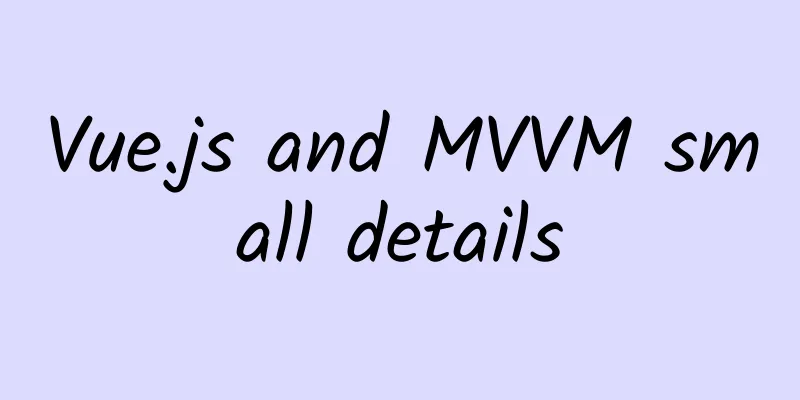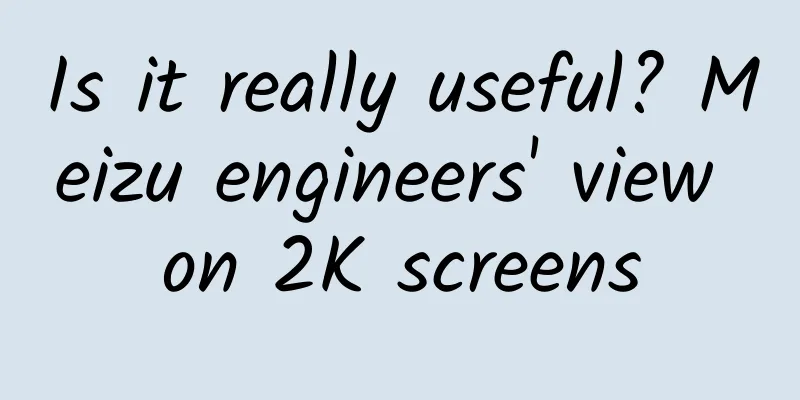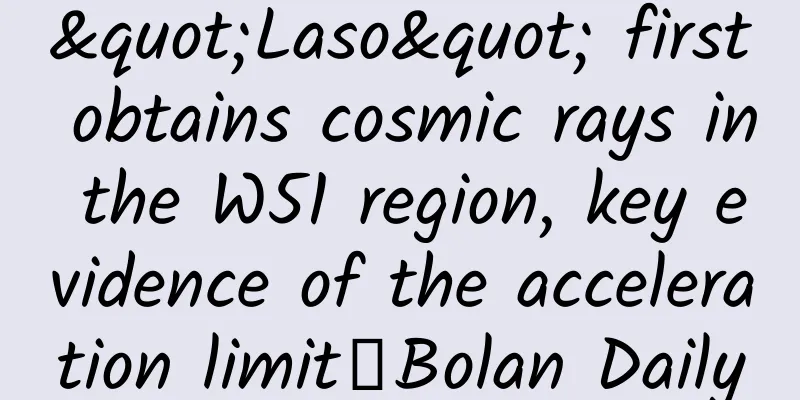Vue.js and MVVM small details

|
MVVM is the abbreviation of Model-View-ViewModel, which is an architectural pattern based on front-end development. Its core is to provide two-way data binding between View and ViewModel, so that the state changes of ViewModel can be automatically passed to View, which is the so-called two-way data binding. Vue.js is a Javascript library that provides MVVM-style two-way data binding, focusing on the View layer. Its core is the VM in MVVM, that is, ViewModel. ViewModel is responsible for connecting View and Model to ensure the consistency of view and data. This lightweight architecture makes front-end development more efficient and convenient. 1. Why does MVVM appear?I came into contact with MVVM in 2015, which can be said to be the hottest year for MVVM. Before that, all I knew was MVC. I came into contact with MVC about 5 years ago, in 2011. At that time, I had just learned programming languages, Java, and the classic SSH framework in Java was used to build a standard MVC framework. To be honest, I have used MVC for so many years, but I still don’t have a deep understanding of it. It was not until I came into contact with Vue.js, studied the MVVM architecture concept, and then looked back at MVC that I felt a sense of sudden enlightenment~ MVC is the abbreviation of Model-View-Controller, which means a standard web application is composed of these three parts:
In the years before HTML5 became popular, MVC was OK as the best practice for Web applications. This was because the View layer of Web applications was relatively simple, and the data required by the front end could basically be processed by the back end. The View layer was mainly used for display. At that time, the Controller was advocated to handle complex business logic, so the View layer was relatively lightweight, which is the so-called thin client idea. From 2010 to 2011, the concept of HTML5 was hotly discussed and sought after. In 2012, W3C officially announced that the HTML5 specification had been finalized. In 2013, when I first joined the company, I came into contact with the first HTML5 framework, Sench touch, which is an HTML5 framework for building mobile applications. It completely separates the front-end and back-end, and the front-end adopts the MVC architecture and is maintained as an independent project. 2. Why does the front end need to be engineered and use MVC?Compared with HTML4, the biggest highlight of HTML5 is that it provides some very useful functions for mobile devices, making HTML5 capable of developing apps. The biggest advantage of developing apps with HTML5 is cross-platform, fast iteration and launch, saving labor costs and improving efficiency. Therefore, many companies have begun to transform traditional apps and gradually replace Native with H5. By 2015, most apps on the market were more or less embedded with H5 pages. Since H5 is used to build the App, the View layer is not only responsible for simple data display, but also for managing complex data states and handling various operations on mobile devices. Therefore, the front end also needs to be engineered, and a framework similar to MVC is needed to manage these complex logics and make development more efficient. But the MVC here has changed a little bit:
This MVC architecture model seems OK for simple applications and is in line with the layered idea of software architecture. But in fact, with the continuous development of H5, people hope that applications developed using H5 can be comparable to Native or close to the experience of native apps, so the complexity of front-end applications is different from the past. At this time, front-end development exposes three pain points:
In fact, the early emergence of jQuery was designed to enable the front-end to operate DOM more simply, but it only solved the first problem, and the other two problems always existed with the front-end. 3. The emergence of MVVM can solve the above three problemsMVVM consists of three parts: Model, View, and ViewModel. The Model layer represents the data model, and the business logic of data modification and operation can also be defined in the Model; View represents the UI component, which is responsible for converting the data model into UI for display. ViewModel is an object that synchronizes View and Model. Under the MVVM architecture, there is no direct connection between View and Model. Instead, they interact through ViewModel. The interaction between Model and ViewModel is two-way, so changes in View data will be synchronized to the Model, and changes in Model data will be immediately reflected in the View. ViewModel connects the View layer and the Model layer through two-way data binding, and the synchronization between View and Model is completely automatic and does not require human intervention. Therefore, developers only need to focus on business logic and do not need to manually operate DOM or worry about data status synchronization issues. Complex data status maintenance is completely managed by MVVM. 4. Vue.js DetailsVue.js can be said to be the best practice of MVVM architecture, focusing on ViewModel in MVVM. It not only achieves two-way data binding, but is also a relatively lightweight JS library with a simple API and is easy to use. There are ready-made tutorials on the basics of Vue online, so I will not go into details here. Let's take a brief look at some implementation details of two-way binding in Vue.js: Vue.js uses Object.defineProperty's getters and setters combined with the observer pattern to implement data binding. When a plain Javascript object is passed to a Vue instance as its data option, Vue will traverse its properties and convert them to getters/setters using Object.defineProperty. Users cannot see getters/setters, but internally they allow Vue to track dependencies and notify changes when properties are accessed and modified.
As can be seen from the figure, when new Vue() is executed, Vue enters the initialization phase. On the one hand, Vue will traverse the attributes in the data option and use Object.defineProperty to convert them into getters/setters to implement the data change monitoring function; on the other hand, Vue's instruction compiler Compile scans and parses the instructions of the element node, initializes the view, and subscribes to Watcher to update the view. At this time, Wather will add itself to the message subscriber (Dep), and the initialization is completed. When the data changes, the setter method in the Observer is triggered, and the setter immediately calls Dep.notify(). Dep starts to traverse all subscribers and calls the subscriber's update method. After receiving the notification, the subscriber updates the view accordingly. The above content is my simple understanding and summary of MVVM and Vue.js after more than half a year of project practice. I hope it will be helpful to you! |
<<: A step-by-step guide to spam filtering with Python and Scikit-Learn
Recommend
Can pushing Feiliu to go public revive NetQin’s stock price?
Because its stock price is undervalued, Qihoo 360...
Canada geese: They really exist, they caused a disaster, and they were cleaned up
Recently, the clothing brand "Canada Goose&q...
Growth strategy of the Douyin App
As Douyin exploded in 2019, more and more attenti...
Science Museum丨How many alarm clocks are best for waking up?
The holidays are over and summer is quietly appro...
Combustion batteries: the best partner for short-term space travel
With the sun shining and trees shading, you can t...
Bitcoin has risen from 8,000 to over 100,000 this year. Who is "speculating like crazy"?
I once had a pile of bitcoins in front of me, but...
Advertising skills: Why do others get several times more clicks than you?
In this era where everyone is competing for atten...
Analysis: What’s so clever about Qutoutiao’s fission strategy?
In 2017, a dark horse, Qutoutiao, emerged in the ...
Olympic gold medals are not pure gold anymore! They are made of garbage and old building materials! Countries have started a garbage competition...
The athlete who won an Olympic medal at the Paris...
How much does it cost to customize a mall mini program in Jiyuan?
How much is the customized quotation from Jiyuan ...
Toyota Motor Financial Report: Net profit in Q2 of fiscal year 2024 fell 55% year-on-year
Toyota Motor released its financial report for th...
Foreign media revealed that Huawei's backup operating system is actually Aurora OS: developed based on Sailfish OS and compatible with Android
At present, the statement of "Hongmeng/Ark O...
iOS application architecture discusses the organization and calling scheme of view layer
[[134891]] Preface After the publication of "...
Can AI prevent “them” from eavesdropping on you?
You may have even encountered such a situation: W...
8 Ways to Avoid Ineffective B2B Content Marketing
In 2015, brands’ content output increased 35% fro...









